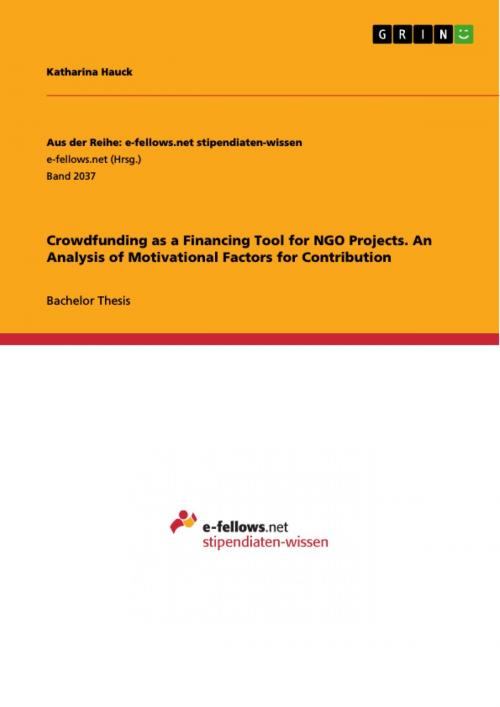Crowdfunding as a Financing Tool for NGO Projects. An Analysis of Motivational Factors for Contribution
Business & Finance, Finance & Investing, Finance| Author: | Katharina Hauck | ISBN: | 9783668266766 |
| Publisher: | GRIN Verlag | Publication: | July 25, 2016 |
| Imprint: | GRIN Verlag | Language: | English |
| Author: | Katharina Hauck |
| ISBN: | 9783668266766 |
| Publisher: | GRIN Verlag |
| Publication: | July 25, 2016 |
| Imprint: | GRIN Verlag |
| Language: | English |
Bachelor Thesis from the year 2015 in the subject Business economics - Investment and Finance, grade: 1,7, University of Applied Sciences Bielefeld (Wirtschaft und Gesundheit), language: English, abstract: Crowdfunding platforms give space to private persons and organizations to publish their projects online and ask for financial support. These projects can be either for profit or non-profit. Although data can, once put online, go viral in no time and become known to many people, there is still much effort needed to create an outstanding project which provides added value to the donor and is thus worth supporting and sharing. By far not every crowdfunding project is successful, and many fundraisers do not yet have the know-how to reach enough funders for their projects. Others even neglect to engage in crowdfunding in the first place, as new possibilities always come along with confusion and insecurity. The central aim of this thesis is therefore to examine how web-based crowdfunding projects must be designed and presented in order to satisfy prospective donors' needs. The main focus lays on the initiation of the funding process. Prospects shall be convinced to become contributors to a crowdfunding campaign in a sustainable, long-term oriented manner. In order to come to the right conclusions, it is necessary to analyze both the fundraisers' and the funders' point of view. First of all, it needs to be clarified how crowdfunding works and what possibilities there are for German fundraisers to realize their campaigns in the most satisfactory manner. Several donation-based crowdfunding platforms in Germany offer different tools and features for their users, being both fundraisers and funders. Furthermore, it will be defined who must be addressed by crowdfunding campaigns and whether these people differ from regular offline donors. To become more specific, the German donors and their preferences in giving will be investigated, concerning both offline and online fundraising. For a more profound analysis of the donors' insights, one has to go back to the very roots of charity and philanthropy: What motivates people to donate to charity? Both the funders' characteristics and the fundraisers' possibilities will be brought together when elaborating the incentives to contribute to a crowdfunding campaign. The design and content of the project page as well as the features of the crowdfunding platform should match the basic motives for becoming a donor. Some of the features already being offered by the platforms fulfill this precondition. In addition, there is potential for new tools making a contribution more probable and assuring long-term relationships to donors.
Bachelor Thesis from the year 2015 in the subject Business economics - Investment and Finance, grade: 1,7, University of Applied Sciences Bielefeld (Wirtschaft und Gesundheit), language: English, abstract: Crowdfunding platforms give space to private persons and organizations to publish their projects online and ask for financial support. These projects can be either for profit or non-profit. Although data can, once put online, go viral in no time and become known to many people, there is still much effort needed to create an outstanding project which provides added value to the donor and is thus worth supporting and sharing. By far not every crowdfunding project is successful, and many fundraisers do not yet have the know-how to reach enough funders for their projects. Others even neglect to engage in crowdfunding in the first place, as new possibilities always come along with confusion and insecurity. The central aim of this thesis is therefore to examine how web-based crowdfunding projects must be designed and presented in order to satisfy prospective donors' needs. The main focus lays on the initiation of the funding process. Prospects shall be convinced to become contributors to a crowdfunding campaign in a sustainable, long-term oriented manner. In order to come to the right conclusions, it is necessary to analyze both the fundraisers' and the funders' point of view. First of all, it needs to be clarified how crowdfunding works and what possibilities there are for German fundraisers to realize their campaigns in the most satisfactory manner. Several donation-based crowdfunding platforms in Germany offer different tools and features for their users, being both fundraisers and funders. Furthermore, it will be defined who must be addressed by crowdfunding campaigns and whether these people differ from regular offline donors. To become more specific, the German donors and their preferences in giving will be investigated, concerning both offline and online fundraising. For a more profound analysis of the donors' insights, one has to go back to the very roots of charity and philanthropy: What motivates people to donate to charity? Both the funders' characteristics and the fundraisers' possibilities will be brought together when elaborating the incentives to contribute to a crowdfunding campaign. The design and content of the project page as well as the features of the crowdfunding platform should match the basic motives for becoming a donor. Some of the features already being offered by the platforms fulfill this precondition. In addition, there is potential for new tools making a contribution more probable and assuring long-term relationships to donors.















